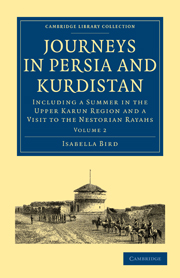 Journeys in Persia and Kurdistan
Journeys in Persia and Kurdistan Book contents
- Frontmatter
- LIST OF ILLUSTRATIONS
- LETTER XVI
- LETTER XVII
- LETTER XVIII
- LETTER XVIII (Continued)
- LETTER XIX
- LETTER XX
- LETTER XXI
- LETTER XXII
- LETTER XXIII
- LETTER XXIV
- LETTER XXV
- LETTER XXV (Continued)
- LETTER XXVI
- NOTES ON PROTESTANT MISSIONS IN URMI
- LETTER XXVII
- FAREWELL IMPRESSIONS OF PERSIA
- LETTER XXVIII
- LETTER XXIX
- LETTER XXIX (Continued)
- LETTER XXX
- LETTER XXXI
- LETTER XXXII
- LETTER XXXIII
- LETTER XXXIV
- LETTER XXXV
- APPENDIX A
- APPENDIX B
- INDEX
- Plate section
- Frontmatter
- LIST OF ILLUSTRATIONS
- LETTER XVI
- LETTER XVII
- LETTER XVIII
- LETTER XVIII (Continued)
- LETTER XIX
- LETTER XX
- LETTER XXI
- LETTER XXII
- LETTER XXIII
- LETTER XXIV
- LETTER XXV
- LETTER XXV (Continued)
- LETTER XXVI
- NOTES ON PROTESTANT MISSIONS IN URMI
- LETTER XXVII
- FAREWELL IMPRESSIONS OF PERSIA
- LETTER XXVIII
- LETTER XXIX
- LETTER XXIX (Continued)
- LETTER XXX
- LETTER XXXI
- LETTER XXXII
- LETTER XXXIII
- LETTER XXXIV
- LETTER XXXV
- APPENDIX A
- APPENDIX B
- INDEX
- Plate section
Summary
Urmi, Oct. 14.
Very few European travellers visit Urmi and its magnificent plain, the “Paradise of Persia,” though it is only 112 miles from Tabriz. Gardens come up to the city walls, and the plain, about fifty miles long by eighteen broad, is cultivated throughout, richly wooded, very populous, and bounded on the east not by a desert with its aridity, but by the blue waters of the Urmi Sea, and on the west by the magnificent mountains of Kurdistan. The city is some miles to the west of the lake.
Urmi is on the whole very pretty and in good repair. The Christian quarter is almost handsome, well built and substantial, and the houses are generally faced with red bricks. The bazars are large and well supplied, and trade is active. The walls and gateways are in good repair, and so is the deep ditch, which can be filled with water, which surrounds them. Every gate is approached by an avenue of noble elœgnus and other fruit trees. The gardens within the walls are very fine, and orchards and vineyards, planes and poplars testify to the abundance of water and the excellent method of its distribution. The altitude is stated at 4400 feet. The estimate of the population varies from 12,000 to 20,000.
Though the Sea of Urmi receives fourteen rivers, some of them by no means insignificant, and has no known outlet, it recedes rather steadily, leaving bare a soil of exceeding richness, and acres of dazzling salt.
- Type
- Chapter
- Information
- Journeys in Persia and KurdistanIncluding a Summer in the Upper Karun Region and a Visit to the Nestorian Rayahs, pp. 235 - 245Publisher: Cambridge University PressPrint publication year: 2010First published in: 1891
